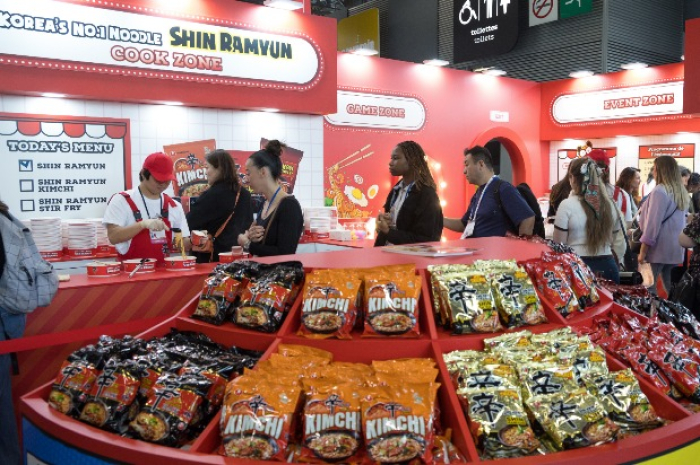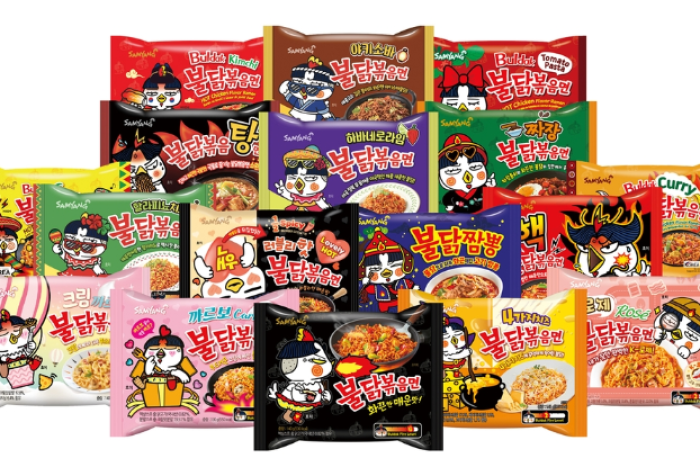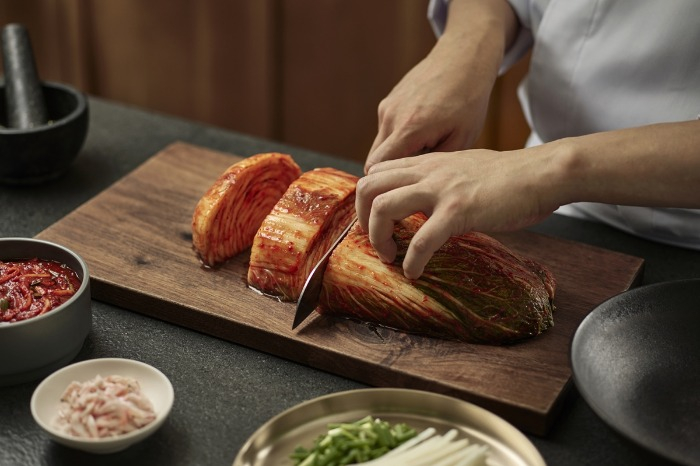Korean food firms chase sizzling K-food demand with expansion
S.Korea’s makers of instant noodles and snacks rush to add new factories at home and abroad
By Jun 14, 2024 (Gmt+09:00)
When in S. Korea, it’s a ritual: Foreigners make stops at CU, GS25, 7-Eleven


Maybe Happy Ending: A robot love story that rewrote Broadway playbook


NPS yet to schedule external manager selection; PE firms’ fundraising woes deepen


US auto parts tariffs take effect; Korea avoids heavy hit


NCSOFT invests in US game startup emptyvessel



South Korean food companies are scrambling to ramp up factory output at home and abroad to meet the insatiable appetite for Korean flavors and aromas worldwide.
According to the Korean food industry on Thursday, the country’s major ramen maker Nongshim Co. will invest 229 billion won ($166.2 million) to build a logistics center in Ulsan, a metropolitan city on the southeastern tip of Korea, by October 2027.
“We have decided to make a new investment to improve the logistics handling capabilities in the Southeast region to meet surging ramen exports,” said an official from Nongshim.
The company operates ramen factories in the region, in Busan and Gumi.
The leading Korean instant noodle maker is also mulling a new ramen-producing factory at home, which would be its first local factory in 17 years.
Earlier in March, Nongshim Chairman Shin Dong-won hinted at the addition of a new ramen factory in Pyeongtaek or Busan to meet strong global demand for its spicy instant noodles.
In February, Nongshim’s archrival Samyang Foods Co. already broke ground on a new factory in Miryang City in South Gyeongsang Province, the second of its kind only two years after the completion of the first ramen factory in the city.

It even decided to expand lines to six from five at the new manufacturing facility earlier this month to cope with the global craze for its Hot Chicken Flavor Ramen, or Buldak-bokkeum-myeon, which shows no sign of abating.
Thanks to the global sensation of Korean instant noodles, Korean ramen exports in the first five months of this year jumped 36.2% from the same period of last year, according to data from Korea’s Ministry of Agriculture, Food and Rural Affairs.
Buoyed by the worldwide Korean ramen boom, Nongshim and Samyang Foods’ stocks have skyrocketed since earlier this year, breaking new record highs in a row in the latest trading sessions.
BEYOND RAMEN SYNDROME
The global fad for Korean food is not limited to ramen.
Korea’s confectionery and snack giant Lotte Wellfood Co. in March announced a plan to invest 220.5 billion won to ramp up the output of its factory in Pyeongtaek and logistics center handling of its Central Distribution Center.
It has also decided to invest 33 billion won to expand the existing factory of its Indian operation Lotte India in Haryana so it can produce Pepero, thin, crispy biscuit sticks coated in chocolate, from the Indian facility.

It also invested 70 billion won to build a new factory for Havmor Ice Cream, the Korean food giant’s ice cream subsidiary in the South Asian country.
Lotte’s crosstown rival Orion Corp. is seeking to build a campus that houses confectionery and snack manufacturing and packaging facilities, as well as a logistics center under one roof in Korea.
It is currently building a potato flake factory in Shenyang, China to complete its construction by the end of this year.
The company is also readying to build a new factory in Hanoi, which would be its third one in the capital city of Vietnam. It has recently purchased land, perhaps for the fourth factory in the city.
BOOM IN KOREAN TRADITIONAL STAPLES
The ongoing K-food popularity, which started with kimchi, instant noodles and snacks, has also made international foodies dig into more diverse Korean flavors and aromas.

Korea’s leading food maker Daesang Corp. earlier this month completed the construction of its second plant in Vietnam, which is expected to increase production of its meal kits and kimchi, the traditional Korean spicy, pickled cabbage dish.
It invested 30 billion won in the new manufacturing facility, which will also produce dried seaweed products.
Sempio Foods Co., a Korean sauce and paste maker, plans to build a new plant in Korea to produce soy sauce, bean paste and meal kits.
Nongshim shares ended at 548,000 won on Friday, up 0.2% from the previous session, while Samyang Foods shares jumped 5.7% to 647,000 won.
Write to Hyung-Joo Oh at ohj@hankyung.com
Sookyung Seo edited this article.
-
 Korean foodDaesang to scale up meal kits, kimchi production in Vietnam
Korean foodDaesang to scale up meal kits, kimchi production in VietnamJun 03, 2024 (Gmt+09:00)
2 Min read -
 Korean stock marketSamyang tops Korean ramen makers by market cap, beating Nongshim
Korean stock marketSamyang tops Korean ramen makers by market cap, beating NongshimMay 17, 2024 (Gmt+09:00)
2 Min read -
 Food & BeverageNongshim to open stores in Leclerc, Carrefour; expands plant in US
Food & BeverageNongshim to open stores in Leclerc, Carrefour; expands plant in USMay 14, 2024 (Gmt+09:00)
2 Min read -
 Food & BeverageNongshim to build instant noodle plant in Korea for exports
Food & BeverageNongshim to build instant noodle plant in Korea for exportsMar 22, 2024 (Gmt+09:00)
3 Min read -
 Korean foodKorea’s ramen exports on course to reach $1 bn in 2024
Korean foodKorea’s ramen exports on course to reach $1 bn in 2024Mar 21, 2024 (Gmt+09:00)
1 Min read -
 EarningsSamyang’s power: Hot Chicken Flavor Ramen by daughter-in-law
EarningsSamyang’s power: Hot Chicken Flavor Ramen by daughter-in-lawFeb 01, 2024 (Gmt+09:00)
2 Min read -

-

-
 Food & BeverageDaesang launches kimchi paste, spread for US, Europe
Food & BeverageDaesang launches kimchi paste, spread for US, EuropeJan 10, 2024 (Gmt+09:00)
1 Min read -
 Korean foodLotte Wellfood ups Choco Pie India sales target to $60 mn with new factory
Korean foodLotte Wellfood ups Choco Pie India sales target to $60 mn with new factoryOct 10, 2023 (Gmt+09:00)
2 Min read -
 Food & BeverageSnack maker Orion earns dividends from Vietnam for 1st time
Food & BeverageSnack maker Orion earns dividends from Vietnam for 1st timeSep 07, 2023 (Gmt+09:00)
1 Min read -
 Food & BeverageSnack maker Orion to pursue M&As, expand Vietnam facility
Food & BeverageSnack maker Orion to pursue M&As, expand Vietnam facilityFeb 08, 2023 (Gmt+09:00)
2 Min read


